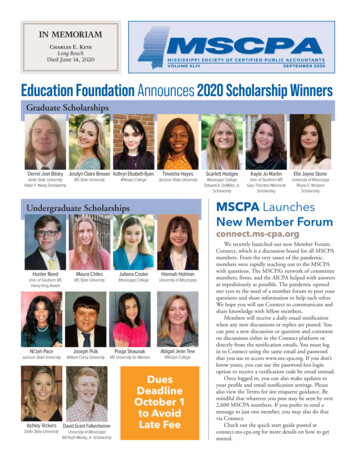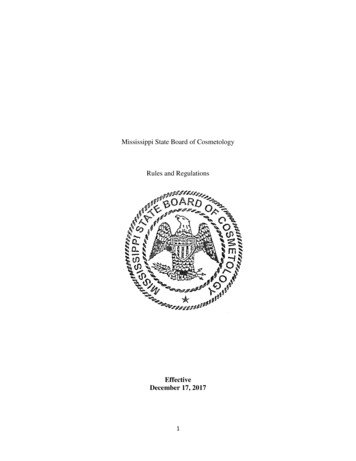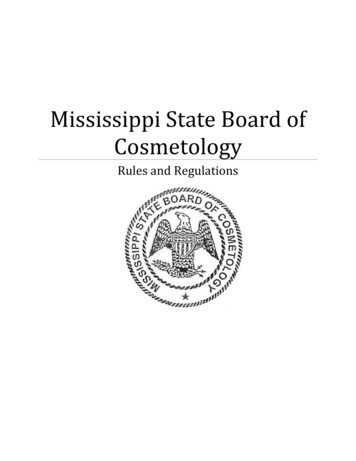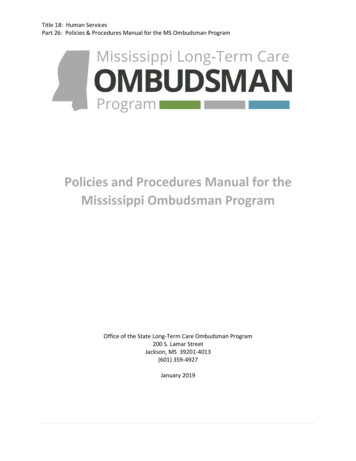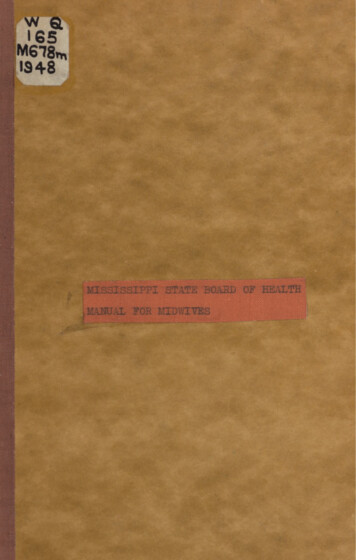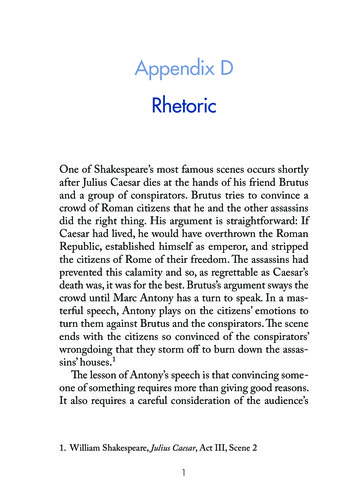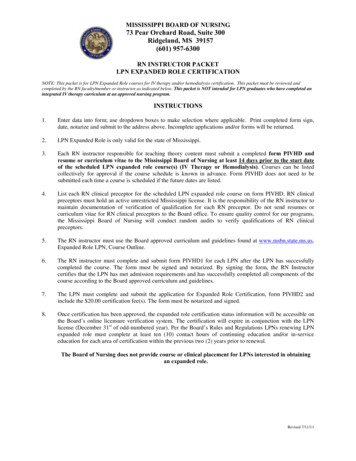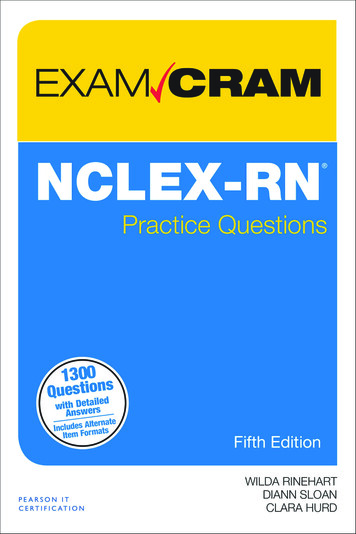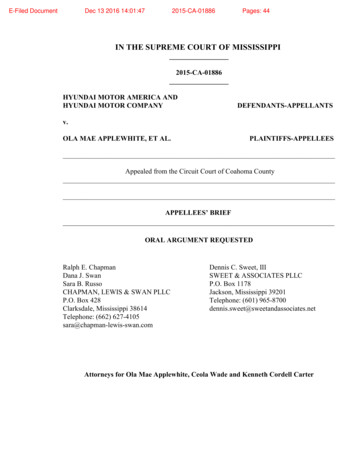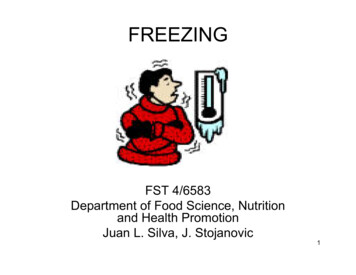
Transcription
FREEZINGFST 4/6583Department of Food Science, Nutritionand Health PromotionJuan L. Silva, J. Stojanovic1
History of freezing2
What is freezing ?A method of food preservation whereby: the heat is removed (heat of fusion) temperature of the food is reduced belowits freezing point (T Tf) and a portion of water in food undergoes achange in state to form ice crystals (Awlowered)3
Preservation by FreezingPreservation achieved by: Low temperature Reduced water activity due to iceformation & high concentration of solutesin unfrozen water Blanching of some foods4
Goal of freezing To prevent growth of microorganisms by–––––Killing some bacteria (little effect)Reducing water activityMechanical formation of ice crystalsOsmotic changes in cell fluidsTying up some free water To lower temperature enough to slow downchemical reactions– (every 10 C decrease in temperature halves thereaction rate)5
FREEZING THEORY6
General definitions Energy– Ability to work Heat– Energy in transit (dynamic) due to thetemperature difference between the sourceand the product7
Specific heat– Is the quantity of heat that is gained or lost bya unit mass of products to a accomplish a unitchange in temperature without the change instate (kJ/kg C) Sensible heat– Is that heat when added or subtracted frommaterial changes their temperature and itcan be sensed Latent heat– Is the heat required to change the physicalstate of materials at constant temperature8
FreezingWhat is the basis for freezing foods?WATER9
WATER CONTENT OF FOODS Food Water 555-7065-818774Freezing Point (ºC)-0.8 to -2.8-0.9 to -2.7-1.7 to -2.2-0.6 to -2.0-0.5-0.510
Water When Water is chilled it reaches its maxdensity at 4 C (Sg 1) and freezes at0 C (Sg 0.917). That is why the icefloats in water11
Food composition Question: WHAT ARE FOODS MADE OF?Answer: WATER EnzymesWater may be free or bound to other components in the food.All water in foods does not freezeFrozen water @-20ºCLamb 88%Fish 91%Egg 93%12
Although food mostly consists of water, itcontains lots of soluble materials Soluble materials slow down the movement ofwater molecules, and the freezing occurs atlower temperature 1gmol of soluble matter will decrease (lower) thefreezing point by 1.86F ( 1C). Freezing points:Fruits and vegetables29-30 FMeat and fish27-28 F13
Freezing Curves for:A- water, B- Binary systemA- waterB- Binary system14
15
Freezing curveSensible heatLatent heatEutectictemperatureSupercooling16
Freezing curves (rates) and ice crystalsFrigoscandia Distribution17
Freezing curve Point AB– Food cooled below freezing point (less than 0)– At point B water remains liquid although thetemperature is below 0 C.– This phenomenon is calledSUPERCOOLING18
Supercooling Going below freezing point without the formationof ice crystals ( crystallization) It yields better quality food than if not present This shows that the undesirable effects offreezing are due to ice formation rather thanreduction of temperature19
Freezing curve Point BC– Temperature rises rapidly to the freezing point(giving off heat of fusion)– Ice crystals begin to form– Latent heat of crystallization is released20
Ice crystals forming- Crystallization Consists of1. Nucleation (site for crystal formation and growth) Association of molecules into a tiny ordered particlessufficient to survive and serve as a site for crystal growth. Itcan be:–––Homogenous (pure water)Heterogeneous (most foods)Dynamic (spontaneous)2. Crystal growth (where it is formed) Is the enlargement of the nucleus by the orderly addition ofmolecules. Crystal growth can occur at temperatures justbelow melting point while nucleation starts at lowertemperature (supercooling)Heat transfer is most responsible for limiting the rate ofcrystallization due to the large amount of latent heatneeded21
Ice crystal growth22
Freezing curve Point CD– Heat is removed as latent heat so theT constant– Major part of ice is formed– In unfrozen liquid there is an increase insolute concentration and that is why thetemperature falls slightly23
Freezing curve Point DE– One of the solutes becomes supersaturatedand crystallizes out.– Latent heat of crystallization is realized andthe temperature rises to EUTECTIC point forthat solute24
EUTECTIC POINT Temperature where there is no further concentrationof solutes due to freezing, thus the solution freezes Temperature at which a crystals of individual soluteexists in equilibrium with the unfrozen liquor and ice Difficult to determine individual eutectic points in thecomplex mixtures of solutes in foods so term FINALEUTECTIC POINT is used Lowest EUTECTIC temperature of the solutes in thefood25
Eutectic temperatures Ice Cream - 55C Meat -50 to -60C Bread -70CMAXIMUM ICE CRYSTALS FORMATIONIS NOT POSSIBLE UNTIL THISTEMPERATURE IS REACHED26
Phase transition diagram and Tg27
Freezing curve Point FG– Temperature of the ice water mixture falls tothe temperature of the freezer– Percentage of water remains unfrozen Food frozen below point E forms a glasswhich encompasses the ice crystals.28
Glass transition temperature, Tg Glass transition temperature:– is the temperature at which the productsundergoes a transition from the rubbery to theglassy state– Formation of glass protects the texture of thefoods and gives good storage stability29
Ice Crystals The location of ice crystals in tissue isthe function of1. Freezing rate SlowRapid2. Specimen temperature3. Nature of the cell30K. Fikiin, 2003, Sofia, Bulgaria
Slow freezing Rates of cooling of less than 1 C/minIce crystals form in extracellular locationsLarge ice crystals formationMaximum dislocation of waterShrinkage (shrunk appearance of cells infrozen state) Less than maximum attainable food quality31
Rapid freezing Produces both extracellular andintracellular (mostly) locations of icecrystals Small ice crystals Numerous ice crystals Minimum dislocation of ice crystals Frozen appearance similar to theunfrozen state Food quality usually superior to thatattained by slow freezing32
Rapid vs. slow freezingRapid freezingThawed foodSlow freezing33
Volume changes The volume of ice is 9% greater than thevolume of water Expansion of foods after freezing would beexpected and depends on:– Moisture content– Cell arrangement– Concentration of solutes (higher concentrationless expansion)– Freezer temperature34
Physical effects of freezing35
CHEMICAL EFFECTS OFFREEZING Concentration of chemicals in liquidphaseIncreased acidityLow pH protein denaturationEffect more pronounced during storageand slow freezing36
Types of chemical changes Flavor and odor deteriorationPigment degradationEnzymatic browningAutoxidation of ascorbic acidProtein insolubilizationLipid oxidation37
Factors that affect chemicalchanges Initial substrate concentrationpH, Aw, OHandling and processingTime and temperature38
Prevention of chemical changes Inactivation of enzymesLow temperature storageAlternation of pHExclusion of oxygen39
MICROBIOLOGY OF FROZENFOOD Growth of microorganisms is temperaturedependent. No pathogens can grow around 5ºC. No microorganisms growth -5º.40
MICROBIOLOGY OF FROZENFOODFreezing cannot kill pathogens if food isalready contaminated !!!!!!!!!!!!However:Some microorganisms are killedSome are injuredSome are OK41
MICROBIOLOGY OF FROZENFOOD During freezing and storage no problem After thawingcontrolled (no problem)uncontrolled (food safety issues)42
MICROBIOLOGY OF FROZENFOOD1.2.3.4.5.NUMBER OF BUGS SURVIVING FREEZINGDEPENDS ONNumber of bugsType of bugStorage temperatureMethod of measurementTemperature fluctuations decrease43
MICROBIOLOGY OF FROZENFOODSUMMARYNeed to: control initial load freeze rapidly store at -18 C (constant) thaw rapidly (low temperature) use immediately, or*store 5 C*cook44
Freezing Foods Pre-freezingFreezingStorageThawing Fruits and VegetablesFrozen fruitsPoultry and meatsSeafoodDairyBakeryPrepared foods45
Pre-freezing foods- F&V Need to control enzymatic reaction Chemical or heat Fruits– Ascorbic acid– Sulfur dioxide– Citric acid Osmoconcentration of fruits– Add sucrose or sugar-syrup Vegetables– Blanching46
Pre-freezing of Muscle Foods Seafood Prepared to freeze Injected w/cryoprotectant Otherwise addedcryoprotectant marinade (tumble) orcryoprotectant breading PoultryPreparedInjected or tumbledFrozen47
Factors that affect freezing (rate) Characteristics of the food: compositionThermal conductivityTemperature differenceFood size (volume to area)Insulating effects (air, package)48
Freezing Types (equipment) Mechanical Slow freezers and sharpfreezers (0.2 cm/h) includingstill-air freezers and coldstores, Quick freezers (0.5-3 cm/h)including air-blast and platefreezers, Rapid freezers (5-10 cm/h)including fluidized-bedfreezing and Ultrarapid freezers (10-100cm/h), that is cryogenicfreezers.– Direct– Indirect (ammonia, others) Cryogenic– CO2– N249
Selection of Freezer Equipment Rate of freezing requiredSize, shape, and packageBatch vs. continuous50
Chest and sharp freezers Inexpensive Temps - 20C and 30C, Slow- no mechanicalmovement51
Blast freezers Temps -30C and -40C at a velocity of 1.5 6.00 ms-1 Many configurations are possible. Fast freezing Continuous vs. batch Potential concerns - freezer burn anddehydration (counter current flow helps)52
Ice-cream or Scraped -surfacefreezer Prefreezing of fluidproducts: ice- creammix Finished freezing inthe “hardening room”53
Belt or Spiral freezers There are modified air-blastfreezers in which a continuousflexible mesh belt is formed intospiral tiers.Spiral freezers require relativelysmall floor-space and have highcapacity (for example a 50-75 cmbelt in a 32-tier spiral processes upto 3000kgh-1).Other advantages includeautomatic loading and unloading,low maintenance costs andflexibility for different products.They are used for a wide range offoods including pizzas, cakes, pies,ice cream, whole fish and chickenportions.54
Fluidized Bed freezer High air flow velocities: 2-5 m/sBed depth: 2-13 cm - both aredetermined by food size andshape.Higher heat transfercoefficients, shorter freezingtimes, higher production rates(l0,000kgh-1) and lessdehydration of unpackagedfood than blast freezing.Limited to particulate foods obviousBOC Gases55
Plate freezer Advantages:- good use of floorspace- low operating costs- little dehydration offood- high rates of heattransfer- food package keepsdimensions Disadvantages:.- high capital costs- size limitations56
Cryogenic freezers Description: Cryogen may be sprayed on food or foodmay be immersed in cryogen. Most common refrigerants - not fluorocarbons Heat content Liquid nitrogen: 48% of the total freezing capacity(enthalpy) is taken up by the latent heat of vaporizationneeded to form the gas; 52% of the enthalpy is availablein the cold gas Carbon dioxide: freezing capacity (85%) is available fromthe subliming solid57
Properties of food cryogensLiquid N2CO2Density (kg m-3)784464Specific heat (liquid) (kJ kg-1K-1)1.02.2Latent heat (kJ kg-1)358352Total usable refrig. effect (kJ kg-1)690565Boiling point (C)-196-78.5 (sub)100-300120-375Consumption per 100 kg of productfrozen (kg)58
Table 21.3--A comparison of freezing methodsTypical film heattransfer coefficientTypical freezing times forspecified foods to -18C (min)6-9180-4320Blast (5 ms-1)25-3015-20Blast (3 ms-1)18Spiral belt2512-1990-1403-4Unpacked peas15Fish fingers7525 kg blocks of fish251 kg carton vegetablesMethod of freezingStill airFluidized bedPlateScraped surface100--Cryogenic (liquid N)1500FoodMeat carcassUnpackaged peas--0.3-0.5Hamburgers; fish fingersIce cream (layer ca.1mmthick)1.5454 g of bread0.9454 g of cake2-5Hamburgers; seafood.5-0.6Fruits and vegetables59
Properties of frozen foodsDensityThermal conductivity, kEnthalpy, H60(Singh and Heldman, 1993)Specific Heat, Cp
Frozen Food Quality Issues Key factors:- storage temperature – generally the colder the better.(costly)- temperature fluctuations – avoid! Practical Storage Life (PSL)Defn: Time that the product maintains product sensoryquality or functionality. A somewhat vague term. High Quality Life (HQL)Defn: Time from freezing until a statistically significantchange in quality is perceived by sensory panel. Just Noticeable Difference – (JND) –The practical storage life of frozen foods as influenced bystorage temperature.(Source: Singh and Heldman, 1993. Introduction to Food Engineering,Academic Press. From IIR International Institute of Refrigeration, 1983,Paris)61
Frozen Food Quality ransportRetailConsumer (Thawing)62
The loss in quality of strawberries during a typical manufacturingthrough distribution chain.Source: Singh and Heldman, 1993. Introduction to Food Engineering, Academic Press. From: Jul, 1984, The Quality of Frozen FoodsStageTime Temperature Acceptabilit(Days)(C)y (Days)Loss per 55611.11Totalstorage(days)344.1Total qualityloss(percent) 77.3063
Defects in frozen foods Freezer burn – fluctuations in temperatureRecrystallizationDrip lossLoss of functionalityChemical reactions64
Dehydration (freezer burn) iscaused by changes in temperatureand differences in RHShrimp that underwent freezer burnFrigoscandia Distribution65
Recrystallization Ice crystals arerelatively unstableUndergo metamorphicchangeShapeSizeOrientationNumberCauses quality loss infood Occurs becausesystems move towardsa state of equilibriumMigratoryrecrystallizationMajor typerecrystallization in foodCaused by a fluctuationin storage temperature66
Migratory recrystallization Surface of food warmsIce on the surfacepartially meltsLarger crystals becomesmallerCrystals less than 2mmdisappearIncreases vaporpressure on the surfaceMoisture migrates tolower pressure Causes food on thesurface to dehydrateWhen temp drops watervapor joins existing icecrystals67
Further reading Fikiin,K. 2003. pdf The freezing process:http://www.ucalgary.ca/ kmuldrew/cryo course/cryo chap6 2.html68
Table 21.3--A comparison of freezing methods Method of freezing Typical film heat transfer coefficient Typical freezing times for specified foods to -18C (min) Food Still air 6-9 180-4320 Meat carcass Blast (5 ms-1) 25-30 15-20 Unpackaged peas Blast (3 ms-1) 18 -- Spiral belt 25 12-19 Hamburgers; fish fingers Fluidized bed 90-140 3-4 Unpacked peas 15 Fish fingers
